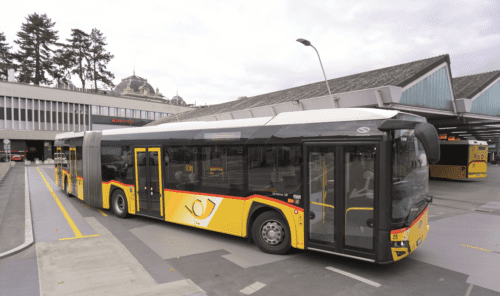
Andrew Thompson takes us to Switzerland for a look at some modern and classic buses
Best known for covering Alpine routes with hairpin roads, the iconic Swiss postal buses actually also run urban and suburban services around the country. The yellow vehicles, known by their German name PostAuto as well as the French PostBus, are a fixture in every region of Switzerland, the first line between the capital Bern and the village of Detligen having been established in 1906.
Originally designed to carry both passengers and parcels as a replacement for the previous horse-drawn postal carriages, the PostAuto buses have only carried people and merely served as public transport since the late 20th century. As such, the publicly owned PostAuto AG remains Switzerland’s largest bus operator and therefore also has a government mandate to go green. As of late 2024 a dispersed fleet of roughly 100 electric buses is already in service around the country and the stated goal is to only operate electric vehicles by 2040.
By 2030 the company wants to achieve net-zero carbon emissions. To this end, a flagship project has been the installation of a new electric charging station, including photovoltaic roof panels at the Brugg bus terminal. Here the local line 361 from Brugg Bahnhof to Windisch Kunzareal functions as a short shuttle route that only takes 8 minutes end-to-end and thus can be operated with just one vehicle. Line 361 has therefore become a proving ground for the deployment of new Scania Citywide e-buses. Other electric models currently in use with PostAuto, include Solaris midi and articulated buses, Iveco midis, plus standard length eCitaros from Mercedes-Benz.
Diesel still needed
Despite the ambitious 2030 and 2040 electrification benchmarks, these green goals do not mean that PostAuto AG has ceased altogether the procurement or introduction of new diesel buses, as these are still needed on long overland routes, where hybrids or electrics are currently not yet suitable for deployment. A large reason for the recent acquisition of a new series of Urbino 18 diesels from Polish bus builder Solaris is that these articulated vehicles will only be in use for about a decade. The average life-span of a Swiss postal bus is just 10 years, during which time they typically rack up
[…]By subscribing you will benefit from:
- Operator & Supplier Profiles
- Face-to-Face Interviews
- Lastest News
- Test Drives and Reviews
- Legal Updates
- Route Focus
- Industry Insider Opinions
- Passenger Perspective
- Vehicle Launches
- and much more!


